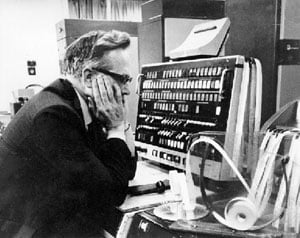3 Facts about Atlas Computer
- Atlas is considered one of the first supercomputers.
- It was the first computer to use virtual memory.
- It championed multiprogramming.
Atlas Computer History
The Atlas computer was developed by Tom Kilburn, an inventor and professor at the University of Manchester. Kilburn and his team began working on Atlas in 1956 and continued to develop it until it was completed in 1962.

This supercomputer was developed in parallel to projects in the United States. It used innovative technologies and parts to offer the first recognizable modern operating system, impressive RAM, and multiprogramming capabilities, though still far from the desktop design of modern computers.
The University of Manchester was eventually joined by Ferranti in 1959. This company helped produce the pilot version of Atlas before three more Atlas 1 versions were produced. Ferranti began commercially advertising the Atlas 2, which was a scaled-down version of the first with less costly parts. Unfortunately, it was considered a commercial failure.
Atlas Computer: How It Worked
The Atlas supercomputer was designed as a research project, but was also part of the MUSE program. This project was designed to create a multiprogramming computer using an operating system to run nuclear physics calculations. It had the equivalent of 96 KB of RAM and 576 KB of storage. Magnetic tape and other innovative parts helped power this supercomputer.

The concept of virtual memory was initially developed by a German physicist—Fritz-Rudolf Güntsch. From their beginnings in the late 1940s, electronic computers had two-level storage systems. In the 1950s, main memory (today it is RAM) was usually magnetic cores, while the secondary memory was usually magnetic drums. The processor could address only the main memory. A major part of a programmer’s job was to devise a good way to divide a program into blocks and to schedule their moves between the levels. The blocks were called “segments” or “pages” and the movement operations “overlays” or “swaps”. The designers of the first operating systems in the 1950s dreamt of relieving the programming burden by automating all this storage management.
After the pioneering work of Fritz-Rudolf Güntsch it became pretty obvious to the designers of operating systems that automatic storage allocation could significantly simplify programming and thus appeared Atlas with the first working prototype of a virtual memory (they called it one-level storage system). At the heart of their idea was a radical innovation—a distinction between “address” and “memory location”. It led them to three inventions:
- They built hardware that automatically translated each address generated by the processor to its current memory location.
- They devised demand paging, an interrupt mechanism triggered by the address translator that moved a missing page of data into the main memory.
- They built a replacement algorithm, a procedure to detect and move the least useful pages back to secondary memory.
Atlas Computer: Installations
The first Atlas was housed at the University of Manchester and was utilized continually 20 hours a day, with up to 1,000 programs being run. The computer was used jointly by Ferranti and the university. Ferranti charged a sum of £500/hour to customers for usage, with part of that going back into the University Computer Earnings Fund. This Atlas was shut down on November 30, 1971.
There were two other Atlas installations that were sold–one jointly to the London University and British Petroleum (1963) and the second to the Atomic Energy Research Establishment (1964). The latter became the largest Atlas, containing 48 kWords of 48-bit core memory and 32 tape drives. This computer was eventually shut down in March 1974.
Atlas Computer: Historical Significance
Tom Kilburn, the inventor of Atlas, SSEM, and other computer systems, created what was considered one of the most powerful computers in the early 1960s. Atlas led to the modern desktop computer by incorporating an operating system to relieve the storage management programming burden.
Atlas is a strong contender for being the world’s first supercomputer. LARC and Stretch were two very similar projects in the United States.
The success of this computer led Kilburn to found the United Kingdom’s first computer science department in 1964.